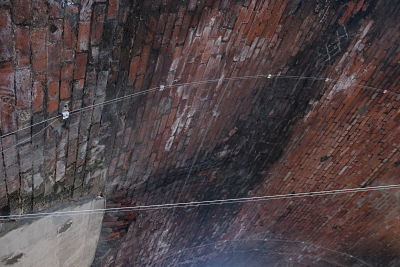Submitted by L. Millard on Fri, 26/02/2016 - 09:29
Masonry arch bridges are an integral part of the UK’s road, rail and waterway infrastructure. These enduring structures have shown themselves to be robust and reliable but many are now facing challenges due to age and modern use.

Image: Instrumentation of the rail viaduct in Leeds
Understanding the behaviour of these bridges will be key to securing their continued effective use. CSIC’s masonry arch bridge research, led by Dr Matthew DeJong and Dr Sinan Acikgoz, aims to quantify the vulnerability of these structures and provide detailed and accurate data that will better inform maintenance programmes and asset management.
CSIC is currently working with Industry Partner Network Rail to monitor an operational rail viaduct in Leeds. In September last year, CSIC began taking measurements of the viaduct’s dynamic response, and the deployment team has now instrumented part of the Victorian railway viaduct to better understand and assess the dynamic and long-term response to loads.
“We are interested in quantifying the dynamic response mechanism of the viaduct to understand if the existing damage intervenes with the load path and, secondly, if the existing damage is progressively getting worse due to temperature cycles and dynamic loads,” said Sinan Acikgoz, Research Associate at CSIC.
Assessment of these structures often relies on visual inspection and engineering experience to establish when and where a bridge requires intervention. CSIC is combining a range of sensing technologies to monitor the dynamic response, with the aim of quantifying degradation and establishing the long-term load capacity.
“This application really takes advantage of distributed sensors. We need to be able to monitor many points on the structure to fully understand how it behaves and responds to loads,” said Sinan.
A number of technologies are being used to gauge the dynamic response, including fiber Bragg grating (FBG) and laser vibrometry. In addition, strain sensing fibre optic cables (BOTDR) and laser scanners are being used to measure the long-term response.
“This instrumentation, which is the first of its kind on this type of masonry arch, offers increased data with an impressive level of accuracy,” said Sinan. “We are currently analysing the data to quantify the responses of the arch to load.
“The bridge is visibly damaged due to water leakage and past settlements and there has already been maintenance intervention. We want to know if the intervention has been successful or if we need to do more.”
The next step is to instrument the adjacent arch to compare and contrast the collected data with that collected from the first arch. This part of the project will take place in early spring.
Potentially there are multiple benefits from this project: “We will combine sensors and modelling tools to form a better picture of the behaviour of these structures. This will provide accurate information for important decision making in asset management which could be of significant value to asset owners and operators.”
